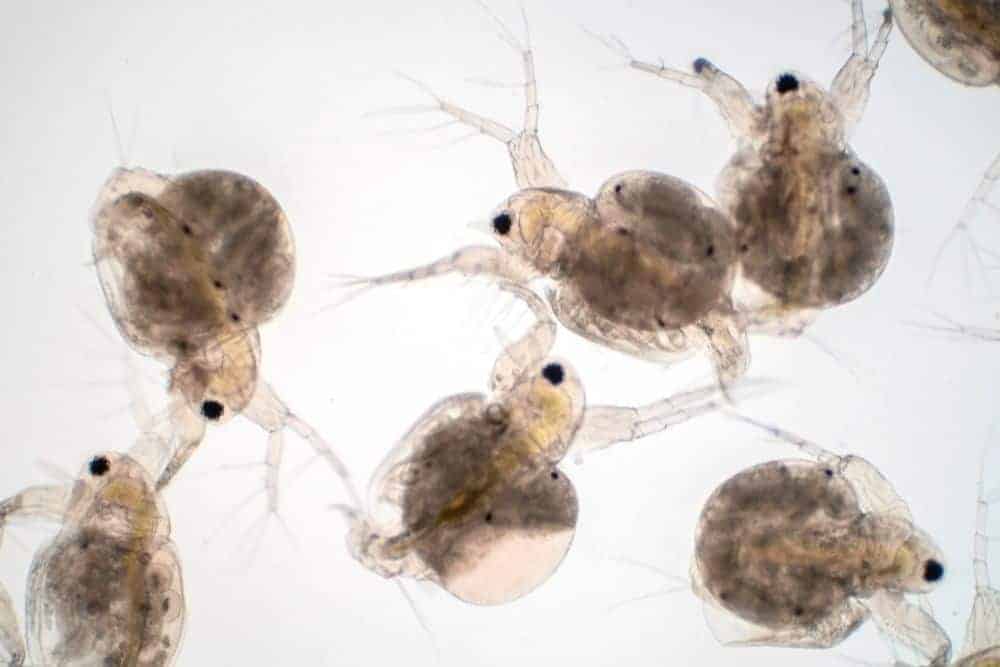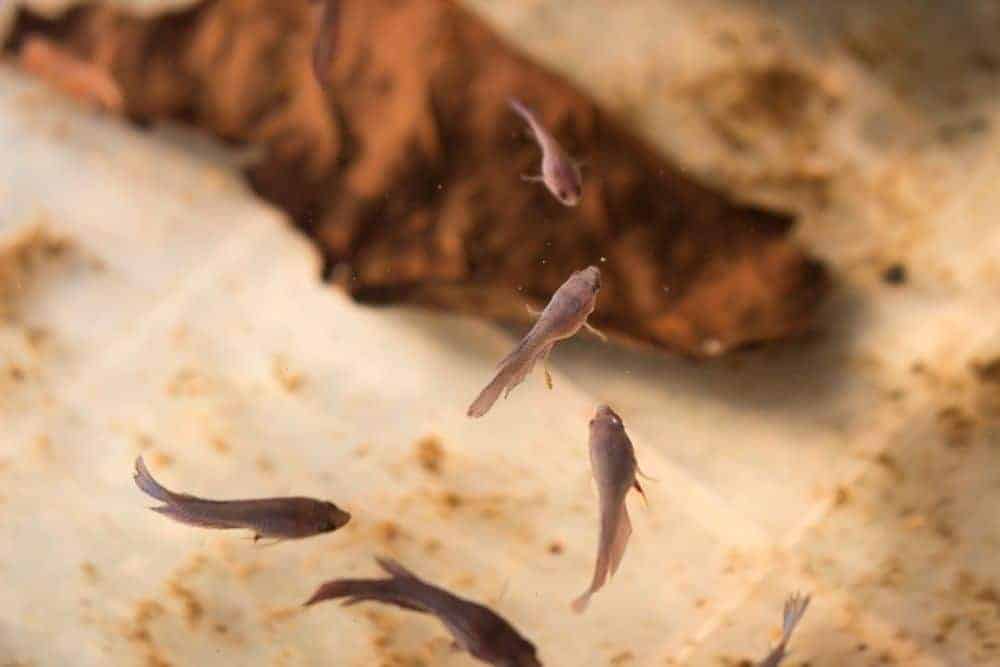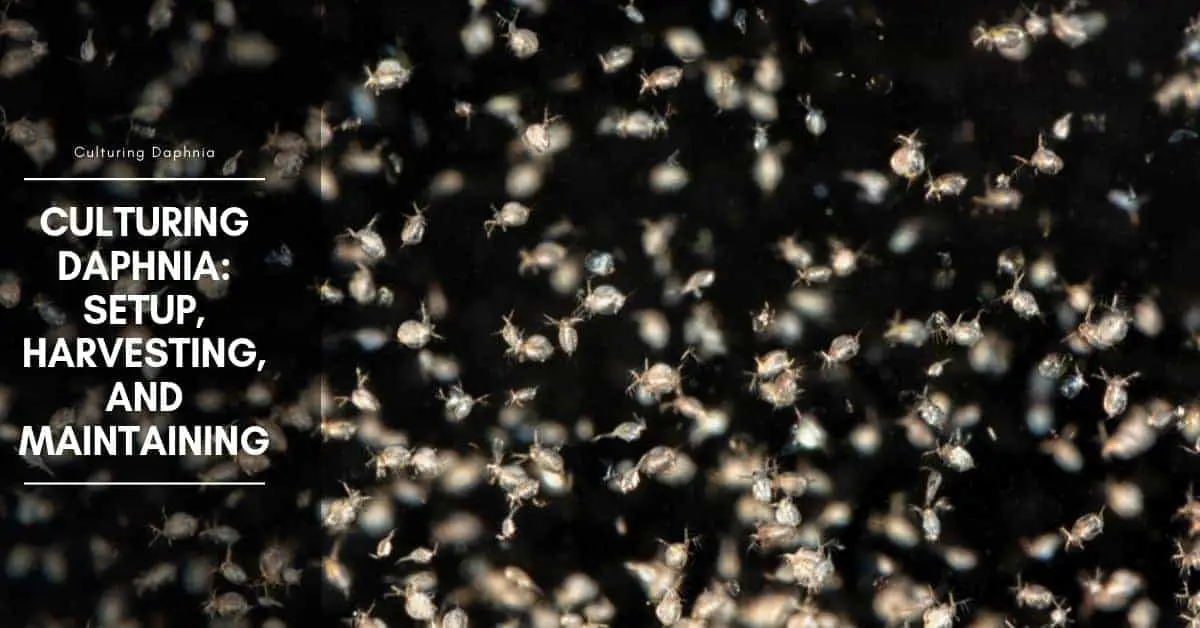These crustaceans are sometimes called water fleas, due to the constant, characteristic hopping motion they make. There are numerous species of cladocerans (the group of crustaceans to which these creatures belong), but for the sake of simplicity, I will use the terms “daphnia” or “water fleas” when I refer to them collectively.
Hobbyists culture only a fraction of the species of water fleas in the world, and those are mainly Daphnia and Moina. There are other genera as well, but it is likely that many of the starter cultures distributed in the aquarium hobby are passed around with little attention to the accuracy of identification.
This is of little practical importance to hobbyists, as all freshwater species are cultured in much the same way. The species commonly cultured vary from only slightly larger than brine shrimp nauplii to several millimeters in diameter. Most fit somewhere in between. It is a simple matter to find a source of daphnia. It may be possible to collect them from the wild if local laws permit, but if you do, be aware that you may unwittingly collect predators, parasites, and pathogens as well. Usually, it is safer to obtain a captive culture.

Some information about culturing daphnia
Difficulty
Moderately Easy. Though the culturing of daphnia is simple, daphnia cultures sometimes crash. With experience and proper care, you can minimize crashes.
Start to Harvest Time
Two or three weeks. If you start with two or three hundred daphnia the population can easily double within a week and continue to do so as long as you harvest daphnia regularly and make regular water changes.
Culture medium
Daphnia are cultured in water.
Uses
The jerky motions of water fleas make them irresistible to most aquarium fish. Some species are quite diminutive so that even adults can be taken by fry that have just outgrown feeding on brine shrimp nauplii (larvae).
Others are big enough to interest larger fish, such as goldfish. Adult daphnia can be added to fry tanks, where they will not only filter small particles out of the water but also provide the growing fry with supplementary meals of newly born daphnia. Their water and chitin content is high for their size, but this can be an advantage: aquarists have long used daphnia as a remedy for constipation in fish.
Water fleas may not be the most nutrient-dense live food but are a favorite with many experienced aquarists to condition fish for breeding. In my experience, daphnia are excellent for this.
API STRESS COAT Aquarium Water Conditioner 16-Ounce Bottle
29% OffAPI STRESS ZYME Freshwater and Saltwater Aquarium Cleaning Solution 16-Ounce Bottle
API ACCU-CLEAR Freshwater Aquarium Water Clarifier 4-Ounce Bottle
12% OffDrawbacks
Daphnia are more sensitive to traces of toxins in the water than most fish. Most strains will not survive in dechlorinated tap water. Aged aquarium water is recommended. Without regular water changes, daphnia cultures are prone to crashing.
What you will need?
Two or more containers between 1/2 gallon (1.89 liters) and 10 gallons (37.8 liters) capacity (more if desired). I usually use eight to ten-gallon buckets for outdoor cultures. Buckets work fine for indoor cultures as well, as do jars and aquariums. Plastic containers can work, but only if they are free of residues. Daphnia are particularly sensitive to oils, soaps, and traces of metals.
Tight-fitting covers for the containers (if you keep your culture outdoors). The lids help reduce evaporation but are mainly intended to keep out inquisitive critters, children, and windblown debris. I use a utility knife to cut sections out of the lid and use craft mesh and zip ties to cover the cutouts. A hole drilled into the lid provides a place to feed a length of airline tubing. For my bucket cultures, I add a small air pump and airline-without an air stone.
Source of dechlorinated water, preferably aged. Water from an established aquarium is ideal for this, provided that it is free of Hydra. See the subheading ‘Daphnia predators’ later in this chapter for more information on Hydra. Fresh tap water, even if it has been dechlorinated, will kill most strains of daphnia. You may be lucky enough to find a strain that is less sensitive, but it is best to err on the side of safety.
A starter culture obtained online or from another aquarist.

Setup and Startup
- As mentioned, culturing methods are largely the same for any freshwater water flea species you may keep. It is worth mentioning that Moina are usually smaller than daphnia and more tolerant of warm temperatures and higher population densities (Rottman et al) but their culture is otherwise identical.
- Select a container or containers of appropriate size(s) If you don’t need large numbers of daphnia, you can successfully raise them in containers as small as 1 quart. During the winter, I often keep a couple of cultures in 1/2 to 1 US gallon glass jars indoors, mainly to have something to stock my larger cultures within the spring. The quantities I obtain from the jars are not great–from a few dozen to a hundred or so per week. For much larger yields, a bigger container is much better. Five to ten-gallon aquariums or buckets can easily provide hundreds of water fleas every day while in peak production. Larger containers can yield even more. Regardless of culture size, it is wise to have at least two cultures going at any given time in case of a mishap. In addition to the previously mentioned indoor jar cultures, I prefer to have two to three culture buckets outdoors from early spring to the middle of fall. Put the container in a place where the temperature will be appropriate and fill the container with water from an established aquarium.
- I cannot stress enough that most daphnia cultured in the hobby are extremely sensitive to dissolved metals and the like in their water, even water treated to neutralize chlorine, chloramine, and heavy metals. Thus, many hobbyists find that the best way to do water changes is to use water from an established aquarium. If you are lucky to have a hardy strain, such as the one I currently keep and also have good municipal water, you may be able to do a 50 percent water change using freshly conditioned tap water with no ill effects. But experience has shown me that not all strains can survive such treatment so I urge you to use water from their aquariums. Just take care not to introduce any daphnia predators, such as Hydra, into the culture. If your culture is indoors, the temperature shouldn’t be a problem–anything in the room temperature range should work. If you culture your water fleas outdoors, 60 to 75 F (15 to 23.8 C) usually seems to result in the best rate of reproduction for my daphnia. That said, water fleas are adaptable, and many species can survive at near freezing and above 85 F (29.4 C). My 10-gallon culture buckets stay outside successfully on a shaded, east-facing porch from March to October, and I live in a climate with hot summers and very cold winters.
- Set up aeration for the container (optional) Aeration is not strictly necessary in daphnia cultures, but it is beneficial and will greatly increase yields. Do not, however, use airstones; fine bubbles can attach to (or worse, lodge inside) a daphnia’s carapace and stress or even kill it. Not a lot of airflow is needed, and a constant slow trickle of bubbles directly from an airline and small air pump is perfect.
- Consider biofiltration. Some consider it difficult to maintain a colony of beneficial bacteria in smaller containers, particularly without aeration. In my experience, however, adding a few square inches of green scrubber pad to the container contributes to the success of the culture–even in small jars. This may be because beneficial bacteria colonize the extensive surface area provided by the scrubbers. If this is the case, a few pinches of gravel or some commercial bio-media could work similarly. Mechanical filtration, on the other hand, is neither necessary nor desirable. Daphnia feeds on tiny particles suspended in the water column; any filter that removed such particles would deprive the water fleas of food or even filter the daphnia themselves out of the water.
- Pay attention to the lighting. Opinions about lighting for daphnia vary. Daphnia are attracted to light, and some culturists say that a strong overhead light will result in the daphnia expending energy trying to reach the light rather than growing and reproducing. Others report increased reproduction with twenty-four-hour lighting. Many culturists have found, as I have, that they get the best results with fairly strong natural light for a short period of the day and ambient light the rest of the time. Water fleas seem to adapt to a wide variety of lighting conditions, so a little experimentation with your own culture may prove fruitful. Cultures that are exposed to a lot of light may grow enough unicellular algae to help feed the daphnia.
Maintaining
Very easy. Biweekly or monthly 20 to 50 percent water changes and daily or almost daily feedings.
Foods
As previously mentioned, daphnia are largely filter feeders. This means that they will collect and ingest just about anything that suspended in the water column and small enough. But not everything they take in provides a balanced diet. Following are some options:
Microalgae
This is a natural food of water fleas in the wild and makes good food for cultures as well. Culturing your own green water, as it is commonly known in the hobby, is not difficult, and is used by many as a staple food for daphnia. Incidentally, at least some species of daphnia will scrape some algae from surfaces such as glass, especially if other food is not available. While unicellular algae constitute good food for daphnia, stringy algae do not, and can actually pose an entangling hazard. If filamentous algae appear in your daphnia culture, remove what you can and reduce light levels until it disappears.
Some aquarists have even used daphnia to filter unicellular algae out of aquaria plagued with green water. Obviously, this method does not work if fish can get to the water fleas.
Spirulina
Even easier than an algae culture is pure Spirulina powder. Spirulina is actually a blue-green alga or cyanobacterium that is sold at health food stores as a dietary supplement. Simply add a small quantity of powder to some daphnia-safe water, shake, and pour into the culture. The little crustaceans do quite well with this as their sole diet. Spirulina can be rather expensive, however, and I’ve noticed that mixing other items in increases productivity of the culture. For these reasons, I now use Spirulina as a component of the diet, rather than the only food.
Yeast
Many culturists recommend a bit of baker’s yeast (commonly used in home baking) dissolved in water as food for water fleas. I’ve used it with success, but prefer other foods, as yeast can be easy to overfeed, resulting in a crash in the population. If you do use yeast, be sure to dissolve it in water before adding it to culture. Adding yeast granules directly to the culture may not always be harmful, but does appear to encourage crashing on some occasions; I strongly recommend against it.
Grain/legume flours
with water to a soupy consistency and fed to water fleas. I have used brown rice flour, whole wheat flour, chickpea flour, and ground dried peas.
Food cocktails
alone, I prefer to use them as ingredients in a mix. This rounds out the nutrients the daphnia get and subsequently pass on to my fish. The daphnia seems more prolific on a mixed diet as well. I have had great success with one part Spirulina powder, one part brown rice or whole wheat flour, and one part pea or chickpea flour. I add a tablespoon or so of this mixture to about 4 ounces of water in a dropper bottle. Keep the liquid in the refrigerator and shake it before each feeding. A small jar culture only requires a drop or two of this mixture per day, while a bucket culture may require two or three droppers full, or more. It is better to underfeed than overfeed, so I recommend increasing food gradually as the culture grows.
Calcium
The exoskeletons of all water fleas contain calcium, so this vital nutrient must be present in the water. Fairly hard water and frequent water changes may be sufficient, but to be on the safe side, I occasionally add a small amount of crushed cuttlebone (sold as a supplement for pet birds) to the culture. Crushed oyster shell or crushed coral could also do the job.
Tankmates
For obvious reasons, keeping fish with daphnia is not recommended, but some non-fish tankmates can actually help provide food for your water fleas, by producing partially digested waste that water-borne microorganisms thrive on. The daphnia, in turn, feeds on the abundant microbial life. Among the species commonly used are snails (particularly mystery, pond, and ramshorn snails); Microflex (Dero digitatis); blackworms; and scuds (amphipods), such as Hyalella Azteca. Feed such a culture on aquarium plant clippings, algae wafers, sinking pellet food, and the like, and you may find that your daphnia obtains a significant amount of their sustenance, or perhaps all of it, in this way.
Harvesting
Harvesting Daphnia in large numbers is easy with a net. Use a brine shrimp net if you want to harvest both young and adults; if you just want adults, use nets with a suitably looser weave. Release each netful into a container of dechlorinated water until you have the desired quantity. It should not take long to collect several hundred if your culture is doing well.
A figure-8 motion, centered in the middle of the container, is the most efficient, at least for a cylindrical bucket. The currents that such a movement creates pull the daphnia towards the center.
- If you want to collect only a few water fleas at a time from a small culture, as I have done when conditioning a pair or two of fish for breeding, keep a drinking straw in or near the culture container. Cover the top end with a finger while it is above the water, and release it when you have the bottom end trained on daphnia or two.
- Cover the straw again and lift.
- Release when you have placed the bottom end over a holding container, or even directly above the aquarium of the fish you are feeding.
The straw also works well to stir the water upon the addition of food, an important consideration in a culture that does not feature aeration.

Hi, my name is Sean, and I’m the primary writer on the site. I’m blogging mostly about freshwater and saltwater aquariums, fish, invertebrates, and plants. I’m experienced in the fishkeeping hobby for many years. Over the years I have kept many tanks, and have recently begun getting more serious in wanting to become a professional aquarist. All my knowledge comes from experience and reading forums and a lot of informative sites. In pursuit of becoming a professional, I also want to inspire as many people as I can to pick up this hobby and keep the public interest growing.
Read more about Sean.
Please join also my Facebook group.




















